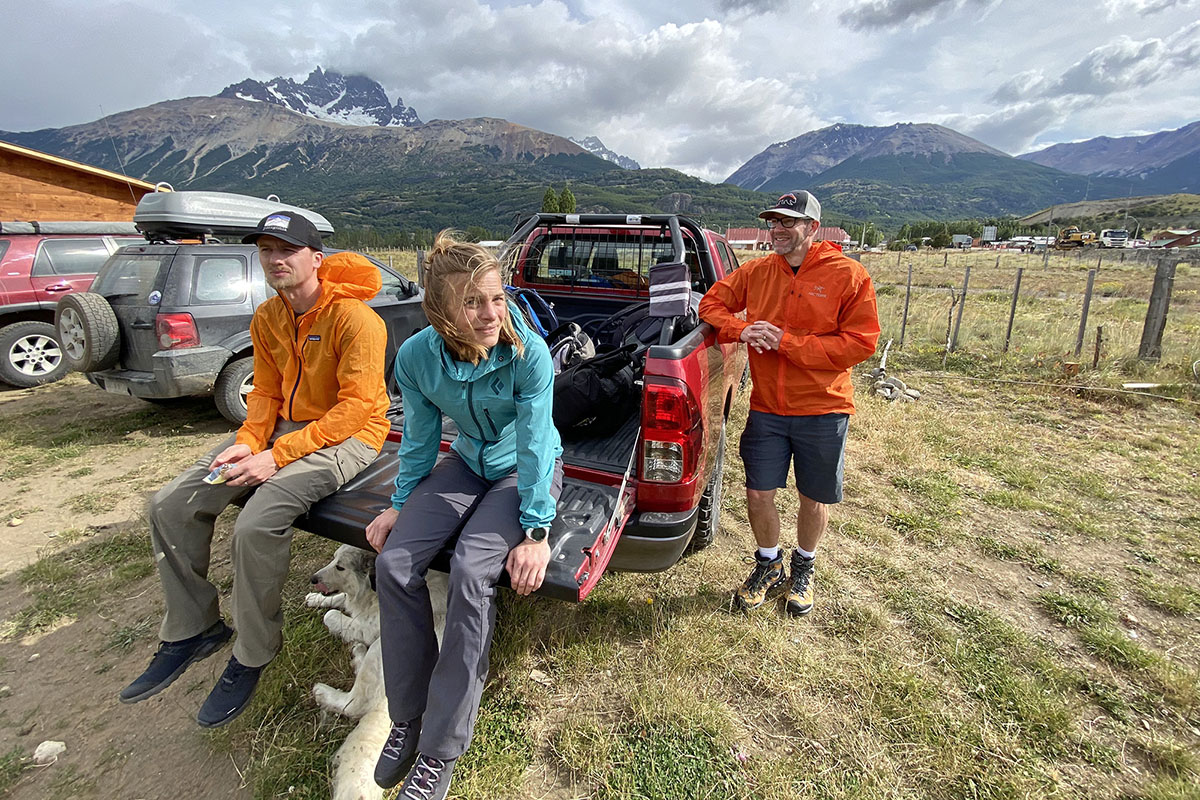
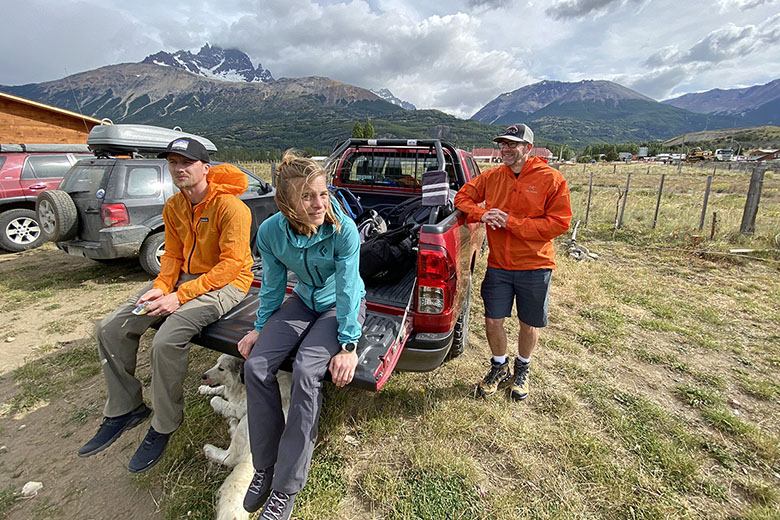
Switchback Travel (David Wilkinson)


Switchback Travel (David Wilkinson)
Let’s get right to the point: We love windbreaker jackets. In our opinion, a good windbreaker is the most versatile outdoor jacket money can buy. These small but mighty outer layers pack a punch, offering serious protection from the elements for hikers, mountain bikers, climbers, and backcountry skiers alike. And more good news: Today's designs are increasingly breathable and comfortable. Below, we break down our favorite windbreaker jackets of 2025, including models for hiking, alpine use, and running. For more background information, see our comparison table and buying advice below the picks, as well as our breakdown on how we approach the testing process.
Editor's note: We updated this guide on July 8, 2025, to add the Flylow Gear Davis and Samara Anorak, as well as the Outdoor Research Deviator Wind Jacket to our list. We also removed several discontinued jackets, moved the Rab Vital up in our rankings, and added photos from recent testing trips. Lastly, we combed through the guide to ensure prices, colorways, and products were current at the time of publishing.
 Category: Hiking/alpine
Category: Hiking/alpine
Weight: 3.7 oz. (men's), 3.4 oz. (women's)
Materials: 100% ripstop nylon
What we like: Great wind protection in a light, packable, and affordable package.
What we don’t: Not the most breathable or comfortable option.
Patagonia’s Houdini is synonymous with the term windbreaker jacket, and for good reason. For years, we’ve trusted this piece to do one thing and do it well: keep wind out. For reference, we’ve been exposed to high winds more times than we can count on exposed alpine ridgelines and rock faces, and have yet to find any weaknesses in the Houdini’s reliability. The 100% ripstop nylon build, while noticeably thin (you can literally see through it), has held up well on overgrown hikes and even scraping against the occasional rock. And perhaps most importantly, the aptly named Houdini disappears into your pack or on your harness when you don't need it. For $109, it’s all the wind protection most climbers, hikers, and mountain bikers need.
This paper-thin Patagonia Houdini is a perfect example of how much warmth you can retain just by blocking airflow. However, breathability is a clear sacrifice: Compared to alternatives like the Black Diamond Alpine Start and Outdoor Research Shadow below, both of which incorporate some stretch, the Houdini is a sizable step down in airflow and grows clammy quickly during exertion. The BD and OR jackets also win out in comfort by a decent margin, thanks to that added “give” in their fabric. And we’d be remiss not to mention Patagonia’s own Houdini Air, which the brand discontinued but was our preferred all-around windbreaker as it was more well-rounded than the standard Houdini. But when weight matters or you don’t anticipate working up a sweat, the regular Houdini is still a reliable windbreaker from one of the top brands in the business, and the approachable price point is the cherry on top.
Read More: Patagonia Houdini review (men's version)
See the Men's Patagonia Houdini See the Women's Patagonia Houdini

 Category: Hiking
Category: Hiking
Weight: 4.4 oz. (men's), 3.7 oz. (women's)
Materials: 100% polyester taffeta
What we like: Affordable, stylish, and functional jacket for hiking and casual use.
What we don’t: Not super breathable, and doesn’t pack down as small as others.
If your idea of a good time looks more like a casual hike than a fast-paced trail run or slog up the skin track, you probably won’t need a top-of-the-line windbreaker—and you shouldn’t have to pay for one either. Enter Cotopaxi’s Teca Windbreaker. We always know a Cotopaxi product when we see it, defined by colorful panels and stylish designs, and the Teca is no exception. Built with 100% remnant fabric, this jacket is far from the most technical offering here, but it certainly is the most eye-catching (and one of the most environmentally friendly). With a large kangaroo pocket, relaxed fit, and the addition of a DWR finish, the Teca is a great choice for casual hikes in the mountains, windy days at the beach, and everything in between.
The Teca offers a roomy fit and the convenience of two hand pockets and a kangaroo zip, which makes it a better choice for everyday use than the more minimalist jackets here. But if you’re on the hunt for a high-performance design, we encourage you to look elsewhere. While not heavy by any means, the Teca is noticeably bulkier when packed down than the Houdini above and many other options below. Plus, its basic polyester build is fairly swampy and not well suited for working up a sweat (Cotopaxi does tack on a rear vent to keep air flowing, which we appreciate). For a more technically savvy budget design, check out the $95 Rab Vital below. At the end of the day, t it’s all about priorities, and the Teca is a nice value for casual adventures and daily use.
See the Men's Cotopaxi Teca Half-Zip See the Women's Cotopaxi Teca Half-Zip

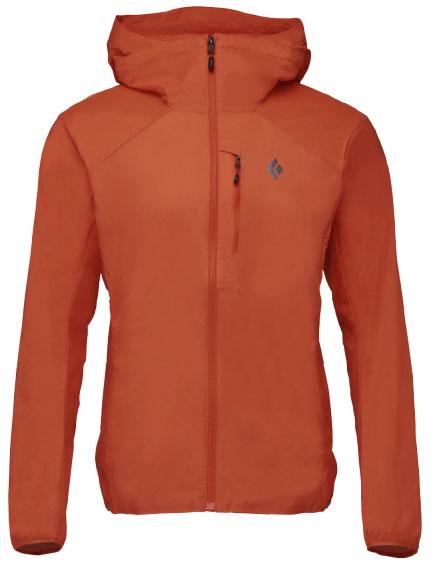 Category: Alpine/hiking
Category: Alpine/hiking
Weight: 7.3 oz. (men's), 6.4 oz. (women's)
Materials: 93% nylon, 7% elastane
What we like: Softshell-like fabric is breathable, stretchy, and very protective.
What we don’t: Not super lightweight or packable.
Ah, the Black Diamond Alpine Start—where do we begin? This jacket has become our layer of choice for everything from windy hikes to daily runs, multi-pitch climbing, and even ski touring. What makes the Alpine Start stand out is its stretchy, softshell-like fabric, which offers great range of motion, impressive breathability, and serious durability. The jacket also features a relatively roomy fit and helmet-compatible hood that are great for colder days in the mountains. And perhaps most significantly, the shell’s robust nature, in addition to Schoeller’s Eco-Repel Bio DWR finish, means you get exceptional protection in wet weather. We’ve worn the Alpine Start in all-day drizzles and blowing snow and never once wished for more jacket.
The most recent update to Black Diamond’s Alpine Start included changes to the fit, better-executed elastic at the cuffs and hem, and a PFC-free DWR finish (it’s also now available in seven sizes for men and women). We do wish BD had retained a drawcord adjustment at the hem, which the previous version had, but the rest of the jacket sticks close to the original formula (which is a good thing). And except for weight and packed size, the Alpine Start tops the Patagonia Houdini above in most categories, including comfort, breathability, and weather resistance. And if you know you need a boost in warmth, the Alpine Start also comes in an insulated version for $90 more. We can wax poetic for days, but we’ll leave you with this: Since we discovered the Alpine Start, our softshell, hardshell, and rain jacket have barely left the closet—now that’s saying something.
See the Men's Black Diamond Alpine Start See the Women's Black Diamond Alpine Start

 Category: Running
Category: Running
Weight: 3.7 oz. (men's), 3.3 oz. (women's)
Materials: 100% stretch polyester w/ knit arms & hood
What we like: Super breathable and great running-specific features.
What we don’t: Not as protective in wind and rain as most windbreaker jackets.
Designed to sweat, Patagonia’s Airshed Pro is built for great temperature regulation during high-output pursuits. Soft and stretchy polyester in the body keeps wind and light moisture out, while a double-knit variety on the hood and sleeves wicks sweat and offers a great next-to-skin feel. A number of running-specific features round out the build, including a two-way front zipper that lets you vent your core while still keeping your neck warm, a single chest pocket for stashing a gel and lip balm (new to the latest version), and sleeves that comfortably push up—and stay there. All in all, it’s an extremely breathable windbreaker jacket that's fine-tuned for movement.
With such a thin polyester body and minimal weather resistance in the knit hood and sleeves, the Airshed Pro is not as protective (or durable) as jackets like the Patagonia Houdini above. As a result, we find ourselves reaching for it on those in-between days—when it's not windy or cold enough to warrant a full windbreaker jacket, but we still want a little something to cut the chill. Finally, keep in mind that the Airshed Pro is very trim-fitting and designed to be worn over a thin baselayer and not much more. All that said, it’s our favorite windbreaker for fair-weather running and can handle a sweat better than most jackets here.
See the Men's Patagonia Airshed Pro See the Women's Patagonia Airshed Pro
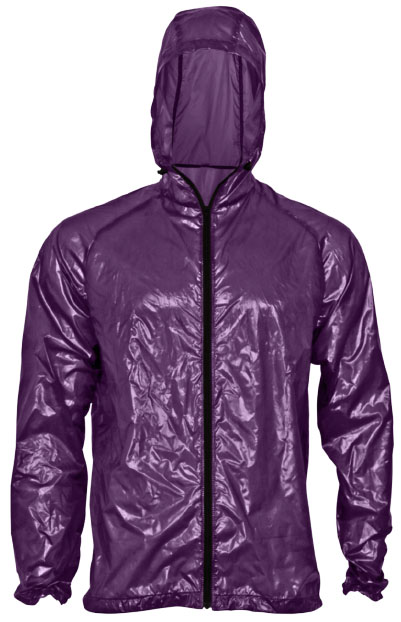 Category: Hiking/running
Category: Hiking/running
Weight: 2.3 oz. (men's), 2.1 oz. (women's)
Materials: 100% nylon
What we like: So lightweight and small you’ll bring it every time.
What we don’t: Doesn’t come with a stuff pocket or stuff sack; shiny exterior.
It might seem strange to have a “best ultralight” superlative in a category that’s inherently ultralight, but the Copperfield is a true standout. This jacket is so small you can stuff it in a pant pocket, the lid of your backpack, the waistband of your running shorts—wherever—and forget about it until the need arises. And when inclement weather does make an apperance, the Copperfield feels like more than just an emergency layer, offering surprisingly good performance thanks to the 100% nylon shell (which is offered in 7, 10, and 20D varieties) and cinches at both the hood and hem. Tack on an excellent build quality (far superior to that of the Zpacks Ventum, a top UL competitor), and a weight of 2.3 ounces (for a men’s medium), and the Copperfield is a really impressive layer.
We love that two of our favorite windbreakers are named after famous magicians (the Houdini and the Copperfield) because we really think these little jackets are magic. But the Copperfield is the true disappearing act of the two. Enlightened Equipment also offers the option of almost 20 colors, which range in terms of thickness, and 14 sizes (note: They run large). Keep in mind that the Copperfield doesn’t come with a stuff sack or stuff pocket—a weight-shaving tactic to be sure—and not everyone will love the uber-shiny sheen. But for full-on function without an ounce (literally) of extraneous detail, the Copperfield is our top ultralight windbreaker of the year. A final note: Enlightened Equipment custom-makes the Copperfield with each order (estimated shipping time is 3 weeks after purchase at the time of publishing), but if you want your jacket to ship in 1-3 business days, check out their in-stock selection.
See the Men's EE Copperfield See the Women's EE Copperfield
 Category: Hiking/running
Category: Hiking/running
Weight: 4.6 oz. (men's), 4.0 oz. (women's)
Materials: 100% nylon
What we like: A technically minded windbreaker that's optimized for running at a great price.
What we don’t: No stuff pocket or stuff sack.
U.K.-based Rab is no stranger to inclement weather, and their Vital Hooded Jacket packs a solid punch for its weight and price. One of our favorite features is the clasp closure at the chest, which allows you to create an opening for airflow without totally sacrificing protection and coverage (or having the open jacket flap around while you're on the move). Rab also equipped the Vital with an adjustable hood that features a stiffened brim to deflect moisture, a YKK front zipper and internal storm flap for added assurance in moisture, a hem cinch, and even repositioned shoulder seams to reduce discomfort from pack straps.
For just $95 and with a nice selection of bright colorways to choose from (ideal if you run or hike at dawn or dusk), the Rab Vital is a really solid value for what you get. And at under 5 ounces (just 4 oz. for the women's version), it's super easy to stow when space is limited. We also happen to really like the way Rab jackets fit and feel, and have had almost zero problems with durability with any of their layers (some of which we've been wearing for decades, like the Borealis). Overall, the Vital is priced fairly, capable, and well-equipped for frequent outdoor use.
See the Men's Rab Vital Hooded Jacket See the Women's Rab Vital Hooded Jacket
 Category: Alpine/hiking
Category: Alpine/hiking
Weight: 4.7 oz. (men's), 4.3 oz. (women's)
Materials: 100% stretch nylon
What we like: Great performance at a low weight; more affordable than the competition.
What we don’t: Thinner but less streamlined than more performance-focused options.
The big appeal of the Mountain Hardwear Kor AirShell Hoody is the noticeable stretch built into its 100% nylon fabric. This means that the jacket moves and breathes with you better than a no-stretch build, which is great news for everyone from hikers and climbers to backcountry skiers. The Kor AirShell’s Pertex Quantum Air design is impressively windproof and water-resistant as well, resulting in a windbreaker that checks all the boxes for high-performance use. And at 4.7 ounces, its weight is competitive with the likes of the Cotopaxi Teca Half-Zip above and the Outdoor Research Shadow Wind Hoodie below.
The Kor AirShell uses a fairly thin 20D fabric, which translates to a decrease in weather protection and durability depending on what you're getting after, though Pertex Quantum Air fabric is notably tough. The jacket also has an elastic instead of an adjustable hem, and ours fit loose around the waist, which is a bad combo in particularly blustery conditions. Finally, the Kor lacks a chest pocket, though we appreciate the hand pockets and the jacket can be stuffed into one of them for storage (and it has a carabiner loop, which we always love). The hand pockets do add bulk if you're wearing a climbing harness or backpack hipbelt, but depending on your priorities, there’s no denying that they boost the Kor AirShell’s appeal as a functional around-town jacket.
See the Men's MH Kor AirShell See the Women's MH Kor AirShell
 Category: Hiking/alpine
Category: Hiking/alpine
Weight: 5.0 oz. (men's), 4.5 oz. (women's)
Materials: 90% nylon, 10% spandex
What we like: Well-rounded performance and practical feature set.
What we don’t: Not the lightest, most breathable, or fitted layer.
Outdoor Research's Shadow Wind Hoodie is reminiscent of a longtime but discontinued favorite: Patagonia's Houdini Air. Like the Houdini Air, the Shadow is made with mostly nylon but adds 10% spandex (the Patagonia had 10% polyester) for a very effective balance of wind-blocking, breathability, and comfort. You also get a practical storage layout that includes two hand pockets and a chest pocket, the latter of which doubles as the stuff sack. For comparison, the Houdini Air had just one chest pocket, although it was lighter by around an ounce. All told, the Shadow Wind was quick to impress us in Chilean Patagonia, where it deftly fended off strong winds while keeping us comfortable and sweat-free in warm and exposed conditions.
No windbreaker is perfect, however, and the OR Shadow is no exception. While reasonably light, the Shadow doesn’t pack down as well for storage as more streamlined designs like the Patagonia Houdini above or the Black Diamond Distance Wind Shell below. Outdoor Research could have trimmed some weight and bulk by simplifying the hood—we almost never utilize the tuck-away feature to stash the hood in the collar. There are also more breathable designs out there, including OR's own Deviator Wind Jacket below, which has a similar construction but includes a perforated backpanel for added airflow. As a final note, we felt the Shadow could use some refinement in its fit: We found it a bit baggy around the chest, which isn't an issue when hiking (and is helpful when wearing over thicker layers), but could get in the way when you want to pick up the pace. But these gripes are far from dealbreakers, and the Shadow has proven more than serviceable for our backpacking and climbing trips of late.
See the Men's OR Shadow Wind Hoodie See the Women's OR Shadow Wind Hoodie
 Category: Hiking/alpine
Category: Hiking/alpine
Weight: 3.5 oz. (men's and women's)
Materials: 100% ripstop nylon
What we like: A close competitor to the top-ranked Houdini, but with a helmet-compatible hood.
What we don’t: Not as breathable or comfortable as higher-end options.
On the surface, Black Diamond’s Distance is your quintessential windbreaker jacket. Like the Patagonia Houdini above, it’s made with 100% ripstop nylon (read: no stretch), has a trim fit and minimalist feature set, and clocks in at a low, sub-4-ounce weight with a very small packed size to match. Added up, it’s a lightweight jacket that can hold its own in inclement mountain weather, although breathability won’t measure up to heavier or pricier models like the Patagonia Airshed Pro and BD Alpine Start above.
The Black Diamond Distance was one of the first windbreaker jackets to use a PFC-free DWR treatment, which eliminates harmful chemicals from the manufacturing process, your body, and the environment. Now, many designs have followed suit, including the Alpine Start and Patagonia models above. Compared to the Houdini, the Distance is slightly lighter and tacks on a helmet-compatible hood, which will be worth it for many climbers. But Black Diamond's classic windbreaker doesn't stand out in any other way, and most users will prefer the Houdini's less slippery grid-style fabric.
See the Men's Black Diamond Distance See the Women's Black Diamond Distance
 Category: Hiking/running
Category: Hiking/running
Weight: 2.5 oz. (men's), 2.3 oz. (women's)
Materials: 100% ripstop nylon
What we like: A fully featured windbreaker for a very low weight.
What we don’t: Very trim fit; 7D fabric is fragile; can be hard to purchase.
Japan-based Montbell is known for making quality, high-performance products that often undercut the competition in terms of weight. Their Tachyon is case in point: This windbreaker features remarkably thin 7-denier ripstop nylon and checks in at just 2.5 ounces—half the heft of a jacket like the Arc’teryx Squamish above. And unlike other ultralight windbreakers that shave weight with minimalist feature sets, the Tachyon manages to include two zippered hand pockets, a stow pocket with Velcro closure, an adjustable hood and elastic waist, and small underarm vents. It all adds up to a streamlined wind jacket that easily fits into the corner of your pack, the waistbelt of your running shorts, or the palm of your hand.
Our most noteworthy gripe about the Tachyon is its fit—when we opted for our standard size, we could barely zip the jacket up. The fabric also has a shiny finish, fairly similar to the Enlightened Equipment Copperfield above. That said, it’s surprisingly supple and breathable—more so than a jacket like the Houdini—and lacks the swishy feel you’d expect from the glossy face. Of course, the thin fabric and streamlined fit mean it’s not our first choice for rock climbing or alpine environments. But for weight- and space-conscious hikers and runners, the Tachyon is a great compromise between the stretchy softshell-like windbreakers and standard nylon varieties here.
See the Men's Montbell Tachyon Hooded See the Women's Montbell Tachyon Hooded

Category: Hiking/skiing
Weight: 5.6 oz. (men’s), 5.2 oz. (women’s)
Materials: 100% ripstop nylon
What we like: A wind layer best suited for the skin track.
What we don’t: Not the most breathable, and the color patterning can be unflattering.
Colorado-based Flylow Gear gained their footing in the ski and snowboard apparel market, but the Davis and Samara Anorak have joined us on more than just spring ski touring adventures. While it’s certainly most at home in cold temps, this layer proved itself as a reliable wind-blocker and warmth-retainer on several early-season backpacking trips and one very drizzly spring marathon in western Washington. The Samara and Davis are outfitted with 100% ripstop nylon and a PFAS-free DWR coating that holds up to light rain and snowflakes. And when the sun comes out, the jacket can be stuffed into its own chest pockets, which is otherwise a great place to store lip balm and sunglasses. These jackets are rounded out nicely with freestyle fits, which slide easily over midlayers and ski bibs without restricting mobility.
There’s a lot to like about the Samara and Davis Anorak, but if there’s one thing these ski layers lack, it’s breathability—not surprising for a wind-focused layer. While the Samara has provided just the right amount of warmth on alpine starts in April, we’ve felt it was a bit too clammy for endeavors later in the season. The anorak zip offers some airflow, but we reach for thinner wind layers as the temperatures rise. And while we haven’t had any issues with mobility to date, some may be dissuaded by the lack of spandex or elastane in the build. Lastly, we have a small gripe with the color blocking on the Samara, which does an unfortunately great job at making our midsection look wider than it is. Aesthetics aside, the Samara and Davis Anorak are yet another win for the snowsports brand, and they've quickly secured a spot in our backcountry ski kit.
See the Men's Flylow Davis Anorak See the Women's Flylow Samara Anorak
 Category: Hiking/running
Category: Hiking/running
Weight: 5.3 oz. (men's), 4.5 oz. (women's)
Materials: 90% nylon, 10% spandex
What we like: A breathable, stretchy, and comfortable wind layer with pockets.
What we don’t: Pricey, chilly, and not the lightest jacket on this list.
Like the other running-specific layers on this list, Outdoor Research’s Deviator Wind Jacket aims to strike the tricky balance of protection, breathability, and low weight. The standout feature of the Deviator is its perforated paneling along the back and underarms, which gives this layer a serious breathability boost in sweat-prone areas. The rest of the jacket follows suit, with a form-fitting yet stretchy nylon and spandex face fabric that moves as you do. And although the Deviator weighs just 5.3 ounces (4.5 oz. for the women's), Outdoor Research managed to include a low-profile zippered chest pocket and two zippered hand pockets for warming up the digits. Most recently, the Deviator joined us on a backpacking trip in the Pasayten Wilderness, where it effectively cut the evening chill of our alpine lake campsite and provided a much-needed barrier from the persistent mosquitoes.
That said, we think the Deviator is a bit of a ‘tweener: It’s not quite warm enough for lower-output activities in cool weather, like backpacking and hiking, but it’s not quite lightweight enough for running or fast-and-light alpine missions. Most notably, we think that OR could trim back the number of pockets to get the weight of this jacket closer to others on this list. We’d also be happy to sacrifice a couple of pockets for the inclusion of a hood, which we sorely missed on windy mountain tops. In our opinion, Patagonia’s Airshed Pro above is a more well-rounded jacket for heart-pumping endeavors: It’s almost an ounce lighter, just as breathable, and comes with a hood. Not to mention, the Deviator is one of the more expensive options here. If you want to stick with Outdoor Research, the Shadow Wind Hoodie above is a slightly cheaper choice with a nearly identical build (with a hood!), though you do forgo the perforated ventilation. All that said, while we think it needs some refinement, the Deviator is far from a poor design, and we've found ourselves reaching for it for all kinds of backpacking, biking, and running missions.
See the Men's OR Deviator Wind Jacket See the Women's OR Deviator Wind Jacket
 Category: Hiking
Category: Hiking
Weight: 12.2 oz. (men's), 10.9 oz. (women's)
Materials: 54% nylon, 46% cotton
What we like: Thick and good-looking.
What we don’t: Heavy and expensive.
Fjallraven does things a little differently than most brands on this list, overlooking factors like weight and packed size in favor of toughness, build quality, and good looks. But don’t be fooled: for certain uses and conditions, we’ve been very impressed with what Fjallraven has to offer. The High Coast Wind Jacket is the heaviest model on this list at 12.2 ounces, uses a combination of polyamide and cotton instead of polyester or nylon, and comes with ample storage including two hand pockets and a zippered chest pocket. Clearly this isn’t your typical wind jacket.
In practice, we’ve found that Fjallraven gear performs best in cool to cold conditions, which makes sense given the company’s Swedish roots. And given the weight, this jacket is ideal for short day hikes or other excursions where you're not worrying about shaving ounces. That said, the heft does have its upsides: The High Coast probably is the thickest jacket on this list, which bodes well for wind resistance and toughness. It’s also extremely well built, more durable than most, and even downright stylish. At the end of the day, it's one of the best windbreakers here for transitioning from trail to around-town use.
See the Men's Fjallraven High Coast See the Women's Fjallraven High Coast
| Windbreaker | Price | Category | Weight | Materials | DWR | Pockets |
|---|---|---|---|---|---|---|
| Patagonia Houdini | $109 | Hiking/alpine | 3.7 oz. | 100% ripstop nylon | Yes | 1 |
| Cotopaxi Teca Half-Zip | $80 | Hiking | 4.4 oz. | 100% polyester taffeta | Yes | 3 |
| Black Diamond Alpine Start | $199 | Alpine/hiking | 7.3 oz. | 93% nylon, 7% elastane | Yes | 1 |
| Patagonia Airshed Pro | $139 | Running | 3.7 oz. | 100% stretch poly w/ knit | Yes | 1 |
| Enlightened Equip. Copperfield | $120 | Hiking/running | 2.3 oz. | 100% nylon | Yes | 0 |
| Rab Vital Hooded Jacket | $95 | Hiking/running | 4.6 oz. | 100% polyamide | Yes | 2 |
| Mtn Hardwear Kor AirShell | $150 | Alpine/hiking | 4.7 oz. | 100% stretch nylon (Pertex) | Yes | 2 |
| OR Shadow Wind Hoodie | $129 | Hiking/alpine | 5.0 oz. | 90% nylon, 10% spandex | No | 3 |
| Black Diamond Distance | $179 | Hiking/alpine | 3.5 oz. | 100% ripstop nylon | Yes | 1 |
| Montbell Tachyon Hooded | $139 | Hiking/running | 2.5 oz. | 100% ripstop nylon | Yes | 3 |
| Flylow Gear Davis Anorak | $120 | Hiking/skiing | 5.6 oz. | 100% ripstop nylon | Yes | 1 |
| OR Deviator Wind Jacket | $145 | Hiking/running | 5.3 oz. | 90% nylon, 10% spandex | No | 3 |
| Fjallraven High Coast | $185 | Hiking | 12.2 oz. | 54% nylon, 46% cotton | No | 3 |
A windbreaker jacket is one of those items we don't leave home without, whether we’re embarking on a day hike, starting up a multi-pitch climb, or heading into the alpine. We first kicked off this guide in 2020 with 17 favorites following a characteristically gusty trip to Patagonia, where knock-you-over winds are a near-constant in the mountains. Editor Maddie Downie took over the guide in 2024, narrowing in on our current lineup of 13 worthy picks with the input of the rest of our team. If Maddie has learned one thing from her alpine adventures in the North Cascades, it's that the weather can go from calm to blustery in an instant.
As we’ve experienced firsthand countless times in the outdoors, wind can be relentless and unpredictable, making a windbreaker jacket a no-brainer for us to always have in our packs. Of course, the primary consideration in testing these pieces is their propensity for sealing out gusts, but we try to weigh that with other important considerations like breathability and durability. Fit will largely come down to personal preference and your intended use(s), but we pay close attention to the silhouette of each jacket as well as any features for dialing in the hem and/or hood. Finally, weight, packability, and features vary between models and will depend on how you prioritize convenience and storage versus keeping weight to a minimum. As with our other outdoor guides, we’ll be sure to keep this list up-to-date as we continue testing and reviewing new and noteworthy designs.

A windbreaker, often referred to as a wind jacket, wind shell, or a wind shirt, serves as a barrier between your body and wind and light precipitation. These jackets are small but mighty—you don’t get full waterproofing or insulation like you might find with a rain jacket or softshell, but the simple act of blocking the wind has a noticeable impact on your body’s ability to hold its warmth. Plus, in addition to a nylon, polyester, or sometimes wool shell material, most have a DWR coating that helps water bead off instead of soaking in. Due to their minimalist build, windbreaker jackets keep weight and bulk to a minimum (many weigh less than 5 ounces and pack up into their own chest pocket) and generally are more affordable than other styles of jackets.
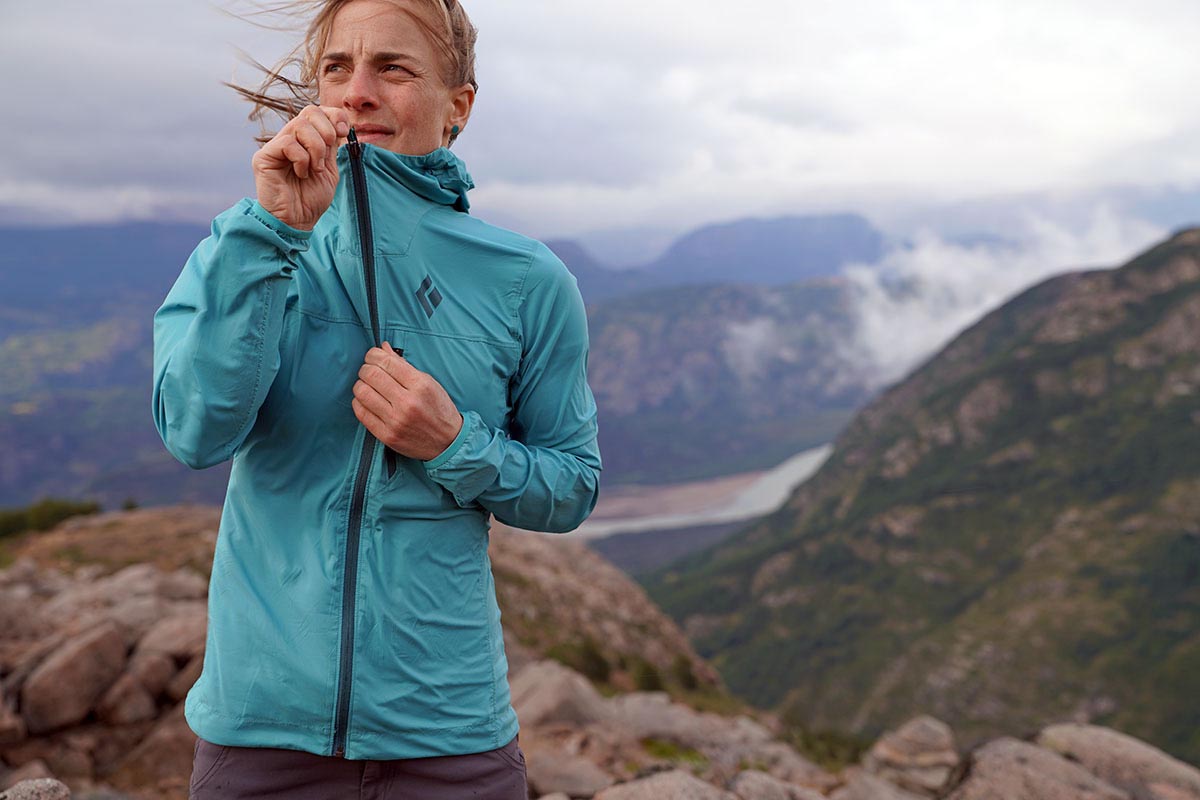
In our opinion, windbreakers are the most versatile piece of outdoor clothing available. For one, they’re so small that there’s always enough room to bring one along, whether it’s stuffed into your hiking pack or clipped to your climbing harness. Second, if you’re anything like us, chances are that most of the time you head outside in mild temperatures and under dry skies. In these conditions, a windbreaker jacket is fully sufficient to keep you warm when a breeze picks up or the sun goes behind a cloud. And with a DWR finish for added water resistance, they are a great option for a lightweight and breathable emergency layer.
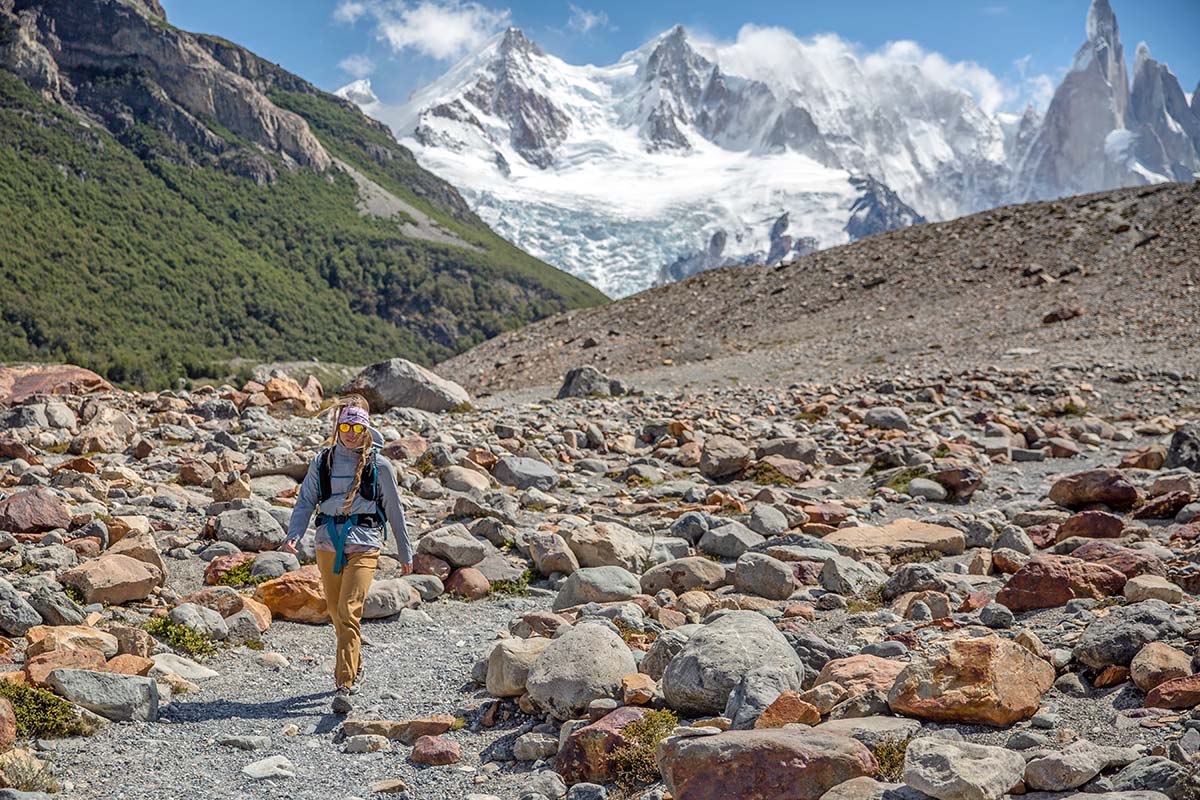
All windbreaker jackets share the common intent of keeping wind at bay but differ in terms of features, weight and packability, weather protection, and more. While some are clearly intended for casual use, others offer great performance where it counts. To help you choose, we’ve separated windbreaker jackets into three general categories: hiking, alpine, and running.
Hiking
Windbreakers in our alpine and running categories below are designed to offer the best in weather protection and breathability for high-performance activities, but not everyone’s idea of fun looks like a high-intensity run or mountain scramble. For lower-output activities when you don’t anticipate generating much of a sweat—think hiking, downhill mountain biking, or traveling in a particularly windy region like Patagonia—there are a variety of windbreakers that can get the job done. Jackets in our hiking category often keep prices low by using thicker and less technical fabrics (you usually don’t see stretch weaves here), which also sacrifice a bit of breathability. In general, these jackets have roomier fits and often feature hand pockets, which are great for everyday use. A few of the most popular windbreakers for hiking (and other low-output activities) are the Patagonia Houdini, Enlightened Equipment Copperfield, and Cotopaxi Teca Half-Zip.
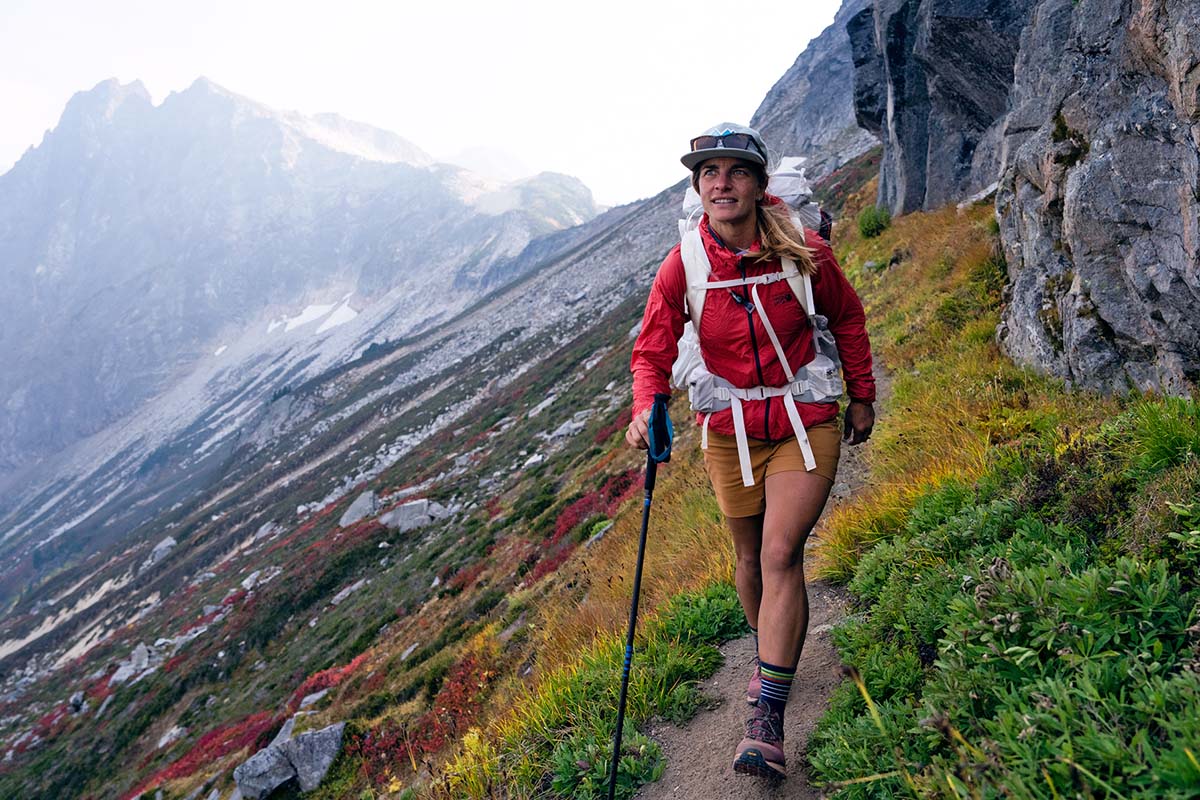
Alpine
Whether we’re embarking on a multi-pitch climb, backcountry ski, or cross-country bike ride, we won’t leave home without a windbreaker. For sports that require a high degree of mobility and breathability, alpine-specific windbreakers often feature stretch in their design, and some are even sized more generously to allow for layering. Here you’ll also see helmet-compatible hoods (often with a simple cinch), packable builds (great for carrying on a harness), and water-resistant finishes. Due to their increased performance, mountain-ready windbreakers can be slightly heavier than the competition, often clocking in above 4 ounces and sometimes as heavy as 7-8 ounces. Our favorite all-around jacket for alpine environments is the Black Diamond Alpine Start Hoody, and the Patagonia Houdini makes an excellent lightweight and packable choice, albeit with a little less protection from the elements.
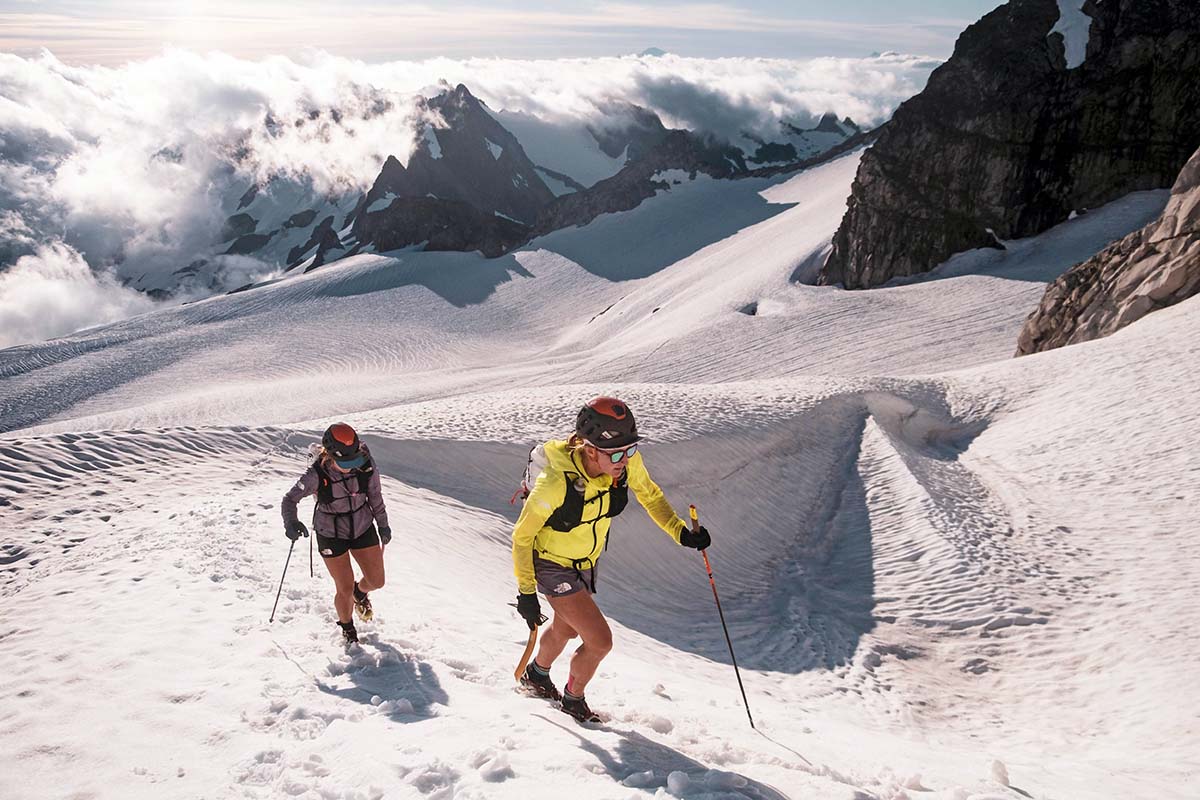
Running
Running-specific windbreakers are designed to keep you protected from the wind without weighing you down or causing you to overheat. Jackets in this category are characterized by trim-fitting builds, minimalist hoods (or no hood at all), low weights (3 to 4 oz. is common), and thin fabrics that offer the height of breathability. Because a jacket’s ability to dump heat is the main priority when you’re constantly building up a sweat (even in cold weather), many running windbreakers incorporate vents or mesh panels into their design as well (such as the OR Deviator's perforated backpanel), which can result in compromised wind and water resistance. In this category we also see reflective strips for road running and built-in carrying features. One of our favorite running windbreakers is the Patagonia Airshed Pro.
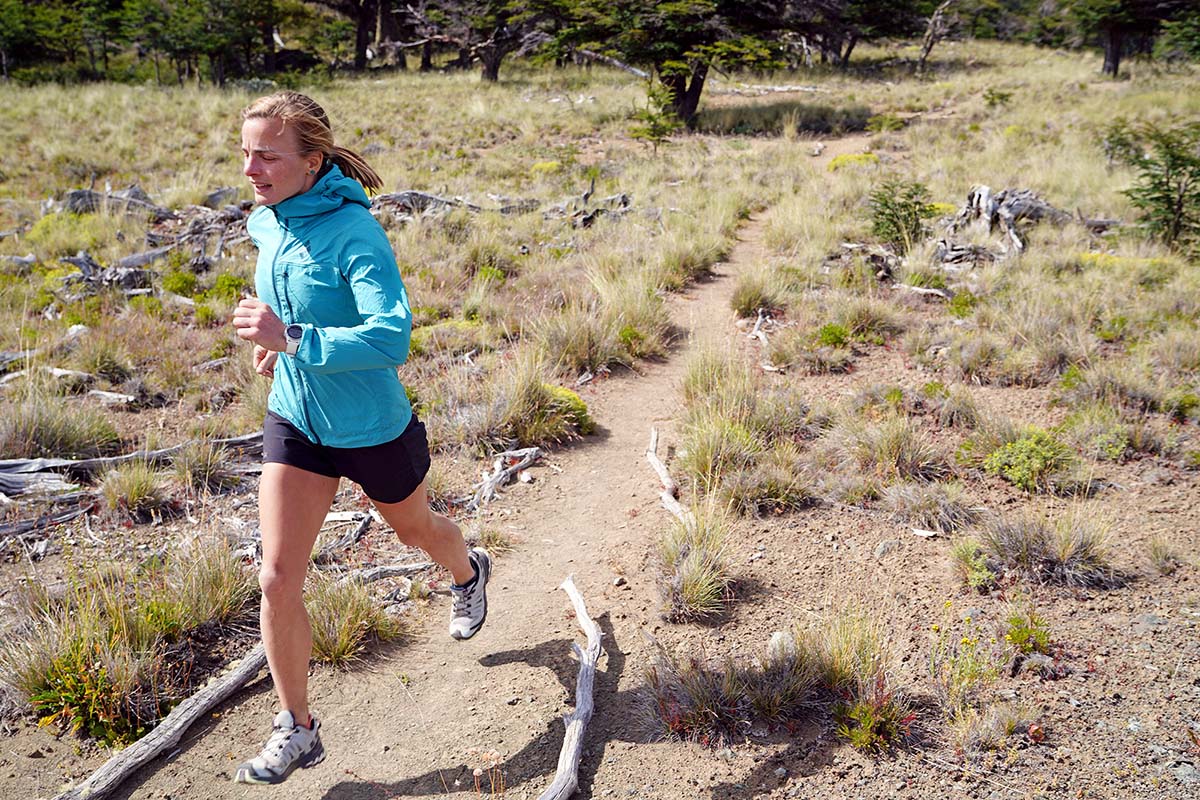
Similar to waterproofness, trying to quantify wind resistance can be a bit tricky. From a technical perspective, manufacturers measure a fabric’s wind resistance in terms of CFM, or cubic feet per minute per square meter. A 0-CFM rated fabric will not allow air to pass at all, and the higher the CFM rating, the more air permeable the fabric. Luckily, brands have found that there’s a certain range at which you can experience a significant increase in breathability without a big difference in wind protection. Thus, each jacket finds a sweet spot CFM depending on its intentions. Some will forgo a little breathability for wind resistance (the Patagonia Houdini is a great example), and others will increase breathability for the trade-off of a bit of protection (that you might not even feel).

In practice, we’ve found these jackets to be quite impressive in blocking out wind despite their low weight and feathery feel. On a recent testing trip to Chilean Patagonia and its legendarily strong gusts that never seem to stop, all four of us basically lived in our respective windbreakers. On one particularly windy trek in the Cerro Castillo region, we literally were blown to the ground on multiple occasions to the point where we had to lay down to avoid getting toppled down the mountain. At some point, that type of situation evolves into hardshell territory where you want maximum thickness and material, but throughout the trip, our wind jackets punched well above their weight and were a true staple.
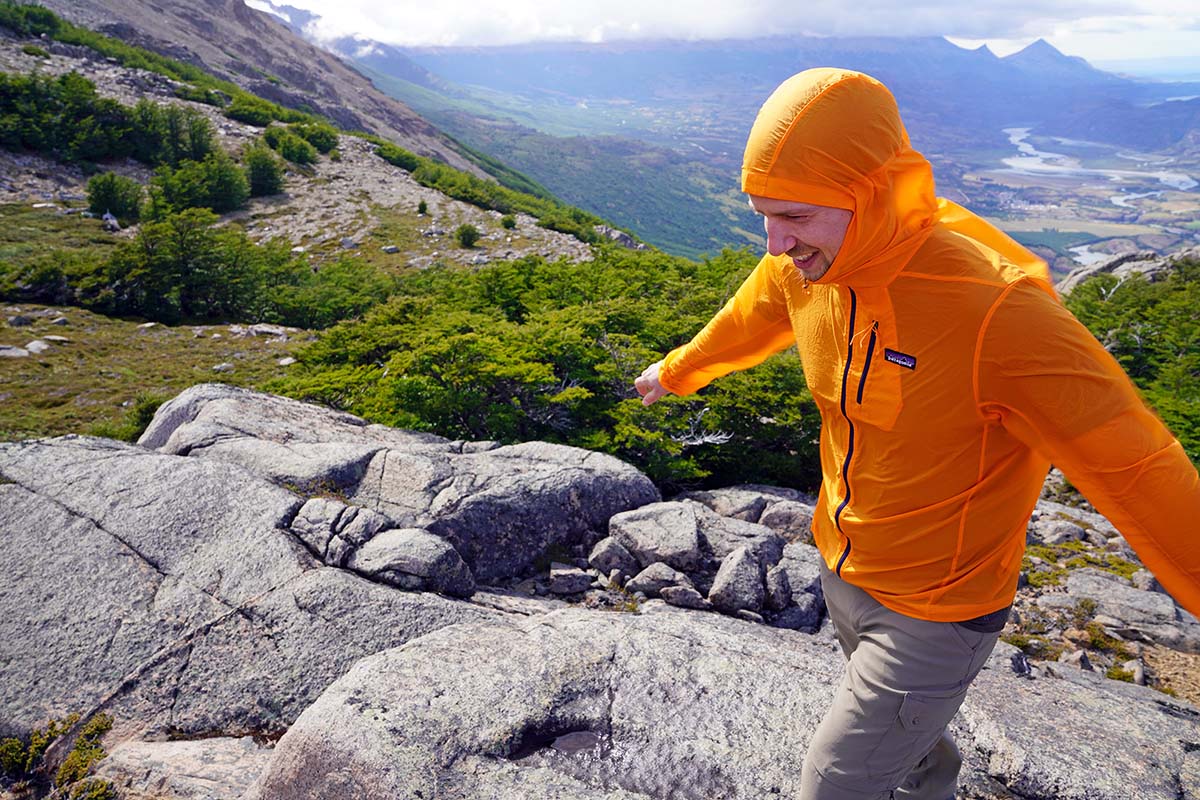
Ah, the great debate. Would you rather have a jacket that blocks air completely (windproof) or one that allows air to move freely from one side to the other (breathable)? As you can imagine, it’s no small task for a fabric to do both. But for those who want to have their cake and eat it too, it’s a good thing you live in this modern era. This category is evolving quickly, and many of the windbreaker jacket models included in this article are fairly competent at both, though Patagonia's Airshed Pro is one of our favorites for breathability.

Before you go looking for the most breathable jacket money can buy, it’s important to consider your end use. If you just plan on using your windbreaker for lower-intensity activities like casual hiking or travel, a less air-permeable jacket will do the trick. Look for 100% nylon or polyester builds here (many of the models in our “hiking” category fit this bill), and the good news is that these models generally come with lower price tags. For high-output activities like running, climbing, backcountry skiing—even rigorous hiking and backpacking—we recommend a more breathable windbreaker. These jackets often are made with stretch-woven fabrics or more complex blends, incorporate features like vents or mesh panels, and are more expensive. To help you navigate these complexities, keep an eye on our category designations—hiking, alpine, and running—to find the best fit for you.
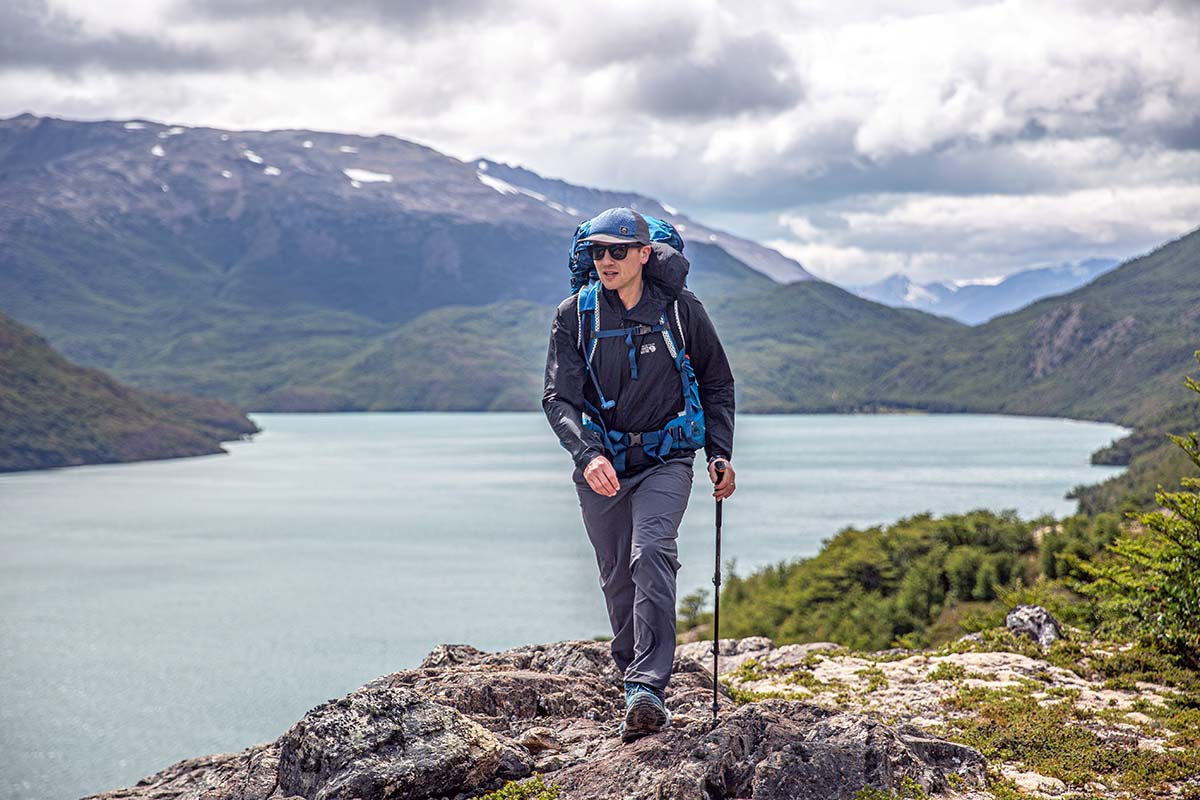
By definition, a windbreaker is not waterproof, but many of the jackets here are impressively water-resistant. Whereas rain jackets or hardshells use a waterproof membrane to keep moisture at bay, windbreakers keep it simple with a durable water repellant (DWR) finish on their outer shell fabric, which causes water to bead up and roll off rather than soak through. It’s important to note that DWR will wear off over time, resulting in diminished water resistance, but it can be reapplied with a spray like Nikwax’s TX.Direct or revived by washing and drying your jacket. And importantly, be on the lookout for jackets with PFC-free DWR, which eliminates harmful chemicals from the manufacturing process, your body, and the environment.

Not every windbreaker will offer added water protection aside from the added barrier of the shell material, so make sure to be on the lookout for a mention of DWR. In the end, we think the water resistance of these windbreakers is good enough for the majority of outings in light precipitation, especially considering that most of us venture outside when the conditions are good. Our experience of late has been very positive: We’ve worn the Black Diamond Alpine Start in everything from all-day drizzles to wet snow and never once felt the need to pull out our shell. Of course, in a sustained downpour, nothing can offer the water protection of a dedicated rain layer. For true backcountry trips, we always bring a waterproof rain jacket or hardshell.
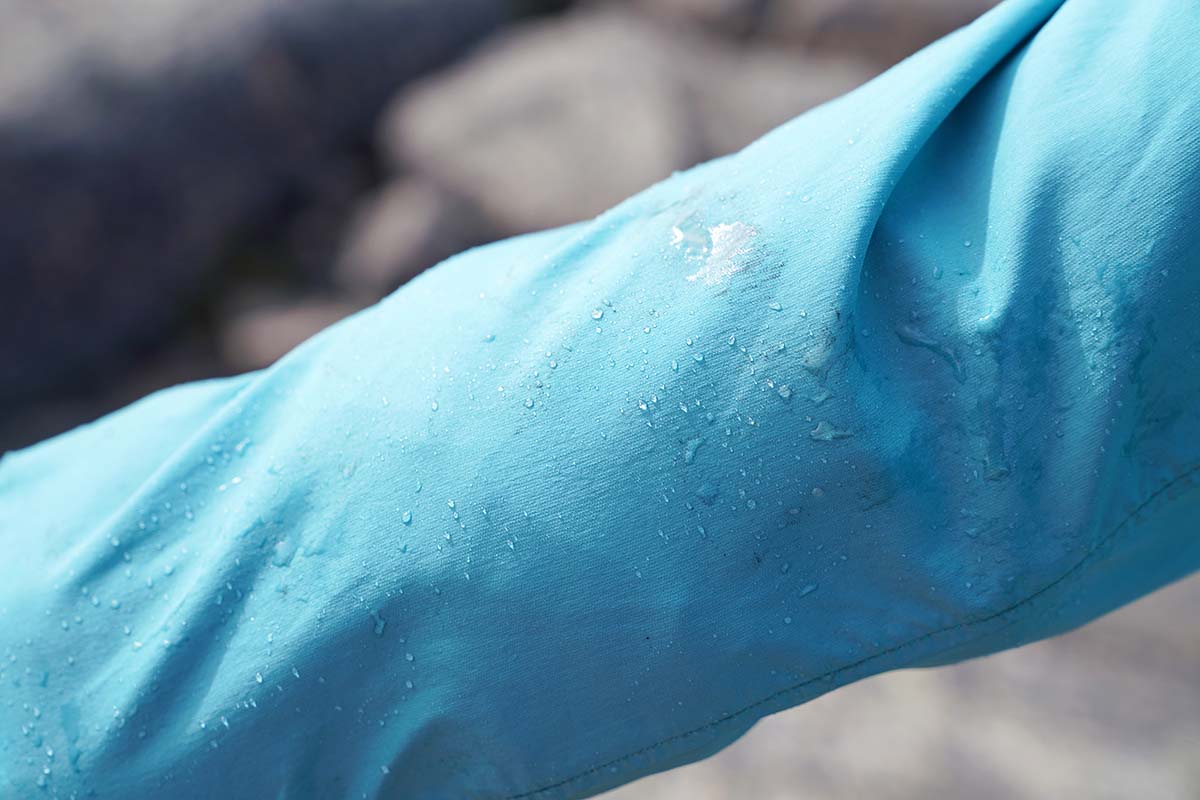
Windbreakers are lightweight and packable by nature, which is one of the main reasons they are such a functional type of jacket. Some designs prioritize minimalism more than others—the ultralight, 1.7-ounce Black Diamond Deploy (currently unavailable), for example, miraculously packs down to the size of a pudgy Clif Bar. But unless you’re a fastpacker or mountain runner with militant weight guidelines, we encourage you to first think about your intended use. Here’s our reasoning: For many people and outdoor activities, the weight difference between a 3.7-ounce jacket like the Patagonia Houdini and a 5.0-ounce jacket like the Outdoor Research Shadow Wind Hoodie is barely perceptible.

That said, there are a few things you can expect with lighter jackets. Most of the time, these are 100% nylon builds (read: no stretch), and can feel akin to wearing a plastic garbage bag during high-intensity activity (unless they have built-in vents or mesh). Lightweight jackets often feature just one chest pocket or no pocket at all, and we see hoodless or pullover styles here too. Often, lighter jackets are very trim-fitting. But not all performance drops with weight. For example, running jackets typically are among the lightest windbreakers, but their thin fabric and generous venting is more suitable for high-output activities than a thicker build. Further, lightweight jackets are not necessarily less wind resistant than heavier options. In short, weight only tells part of the story when it comes to windbreakers. In the end, we encourage you to first determine your end use (Do you prioritize a highly breathable jacket, weather protection, a hood, etc.?) and then use the weight spec to help you whittle down your choice.

In terms of packability, the majority of windbreaker jackets are designed to stuff into their own chest or hip pocket, which usually includes a carabiner loop on the inside. For on-the-go activities such as climbing, this feature is invaluable: You can clip your jacket to your harness with a carabiner and eliminate the need for a backpack (which can be very burdensome when climbing). You’ll want to consider the bulk of the packed jacket as well, as some will be more onerous for harness or hand carry than others. Usually weight, features, and fabrics (100% nylon is the most packable and stretch-woven fabrics will be the least packable) are a good indicator of bulk.

The majority of windbreaker jackets are made with 100% nylon or polyester. With just a few exceptions, these simple weaves have little to no stretch, meaning they don’t offer great freedom of movement. Further, 100% nylon or polyester jackets often suffer in terms of breathability, with tight weaves that aren’t particularly air permeable. But these jackets still have a lot going for them: They are the lightest and most packable designs (particularly nylon) and often the most affordable (particularly polyester). Additionally, with features like gusseted underarms and drop tail hems, many are able to add ample mobility. We wore the 100% nylon Patagonia Houdini for years as our climbing windbreaker of choice, benefitting from its lightweight wind protection while embracing its compromises as simply part of the package.
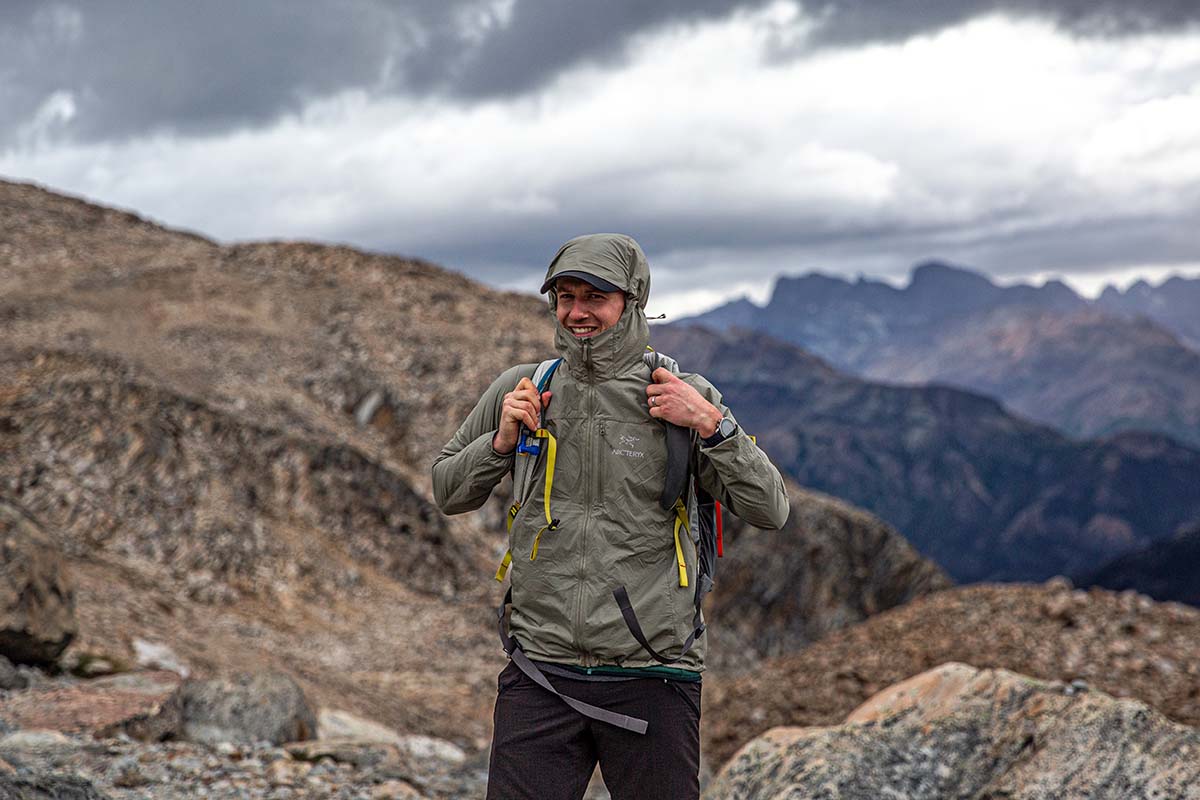
However, more and more designs incorporate stretch into their fabric, either by way of their weave (like we see in the Patagonia Airshed Pro) or by adding a small amount of elastane/spandex (as with the Outdoor Research Shadow). No matter how it’s accomplished, the result of added stretch is better mobility, increased breathability, and a softer next-to-skin feel. In other words, these are your premium windbreakers. Of course, top-notch performance comes with trade-offs: Most of the time, stretch woven fabric is heavier and bulkier than straight nylon or polyester, and it’s often more expensive, too. Further, as we learned above, increased breathability (read: air permeability) inherently impacts wind resistance—although not to a noticeable extent, in our experience.
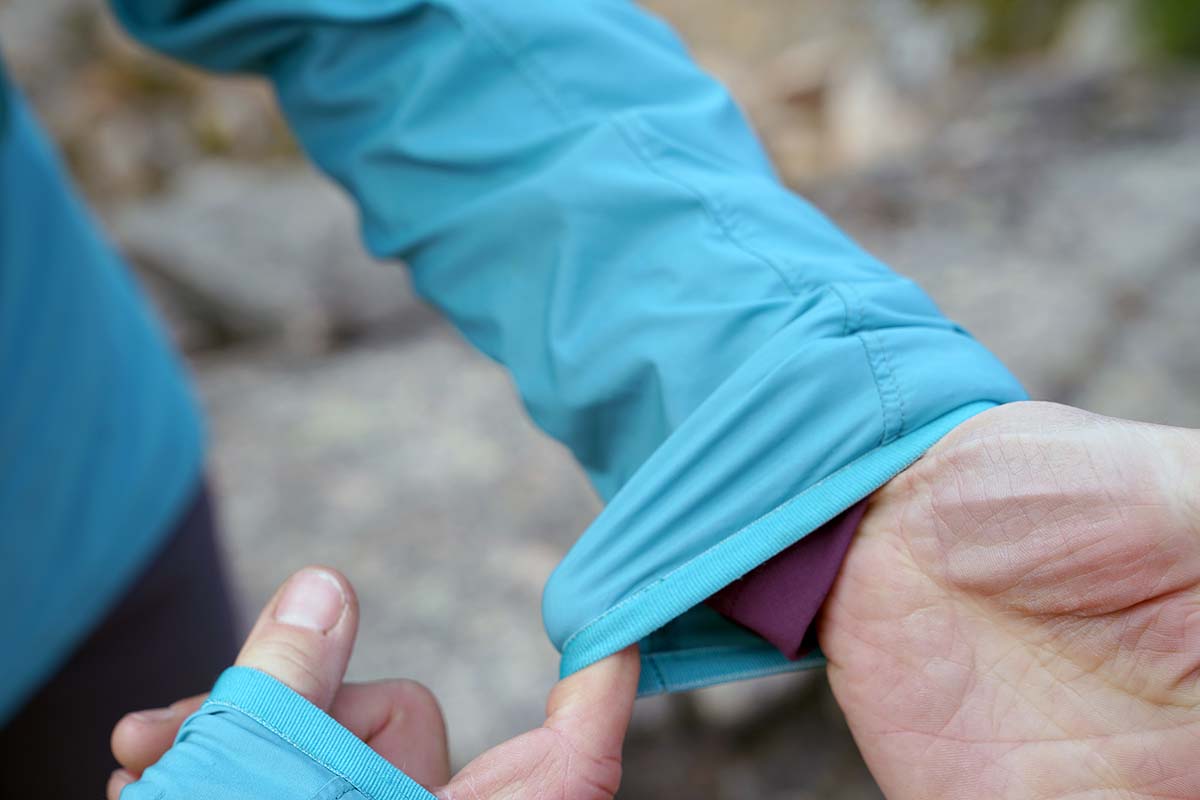
Given that windbreaker jackets are minimalist in nature, most are designed with a trim fit. In addition to shedding ounces and bulk off the build, this also means you won’t have any excess material getting in the way, which is great for activities like running and climbing. For this reason, we see the most streamlined fits in our ultralight running models (like the Patagonia Airshed Pro) and some ultralight alpine designs (the Patagonia Houdini, for example), both of which can accommodate a thin shirt or baselayer underneath—but not much more. On the other hand, some of the styles in our hiking category (the Cotopaxi Teca, for example) and a few mountain-specific designs have a roomier fit that can be layered over an insulated jacket.

In our experience, the trim fit of windbreakers makes sense for most uses. If you’re running, working hard on the skin track, or climbing on the sharp end, you’ll likely be building enough heat to only need a light baselayer underneath. At the belay or during a transition, you can always throw your insulated jacket on over top. For some, however—especially those who run cold, need the extra freedom of movement, or plan to use their windbreaker in the cold—it can be a good idea to size up to accommodate more layers underneath (we’ve appreciated the extra room in the Black Diamond Alpine Start while ski touring the past couple winters). Many of our product descriptions above include comments on fit.
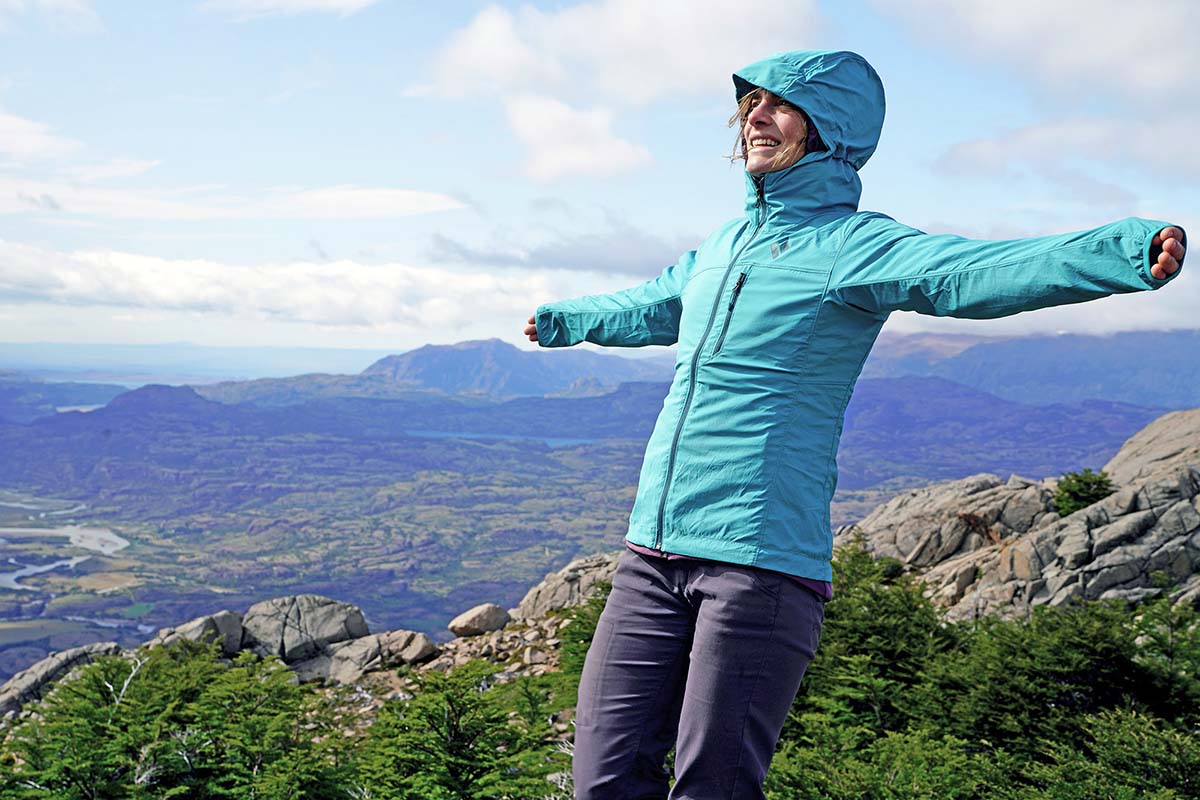
In general, windbreakers have stripped-down feature sets that place a priority on weight savings and packability. Most jackets have a single chest pocket that doubles as a stuff sack, a simple hood adjustment, and a hem cinch. Some models, particularly those in our alpine category, will have larger helmet-compatible hoods, while other designs will cut weight by removing the hood completely. In terms of the zipper, most jackets have a full-length zipper, although some ultralight models cut weight with a pullover design (like the Patagonia Airshed Pro). If you’re looking for a step up in features, our hiking category is a good place to start. With less of an emphasis on ounce-counting, many of these jackets offer a larger range of adjustment and more pockets.
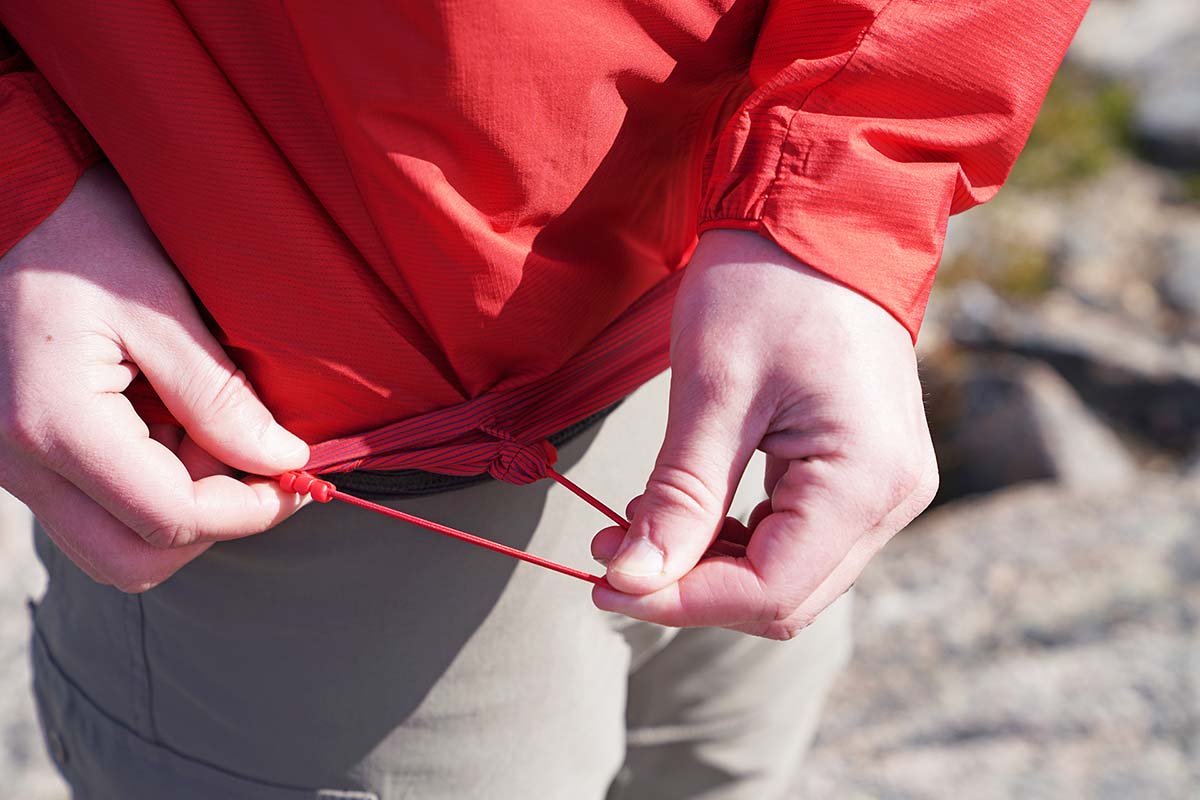
Ultralight and thin by design, you aren’t out to lunch if you are worried about the durability of windbreaker jackets. To stack the odds in your favor, it’s a good idea to look for ripstop fabrics (like the Black Diamond Distance) or stretch-woven material that gives under pressure rather than rips (like on the Mountain Hardwear Kor AirShell Hoody). Thicker shells—indicated with higher denier ratings, grams per square meter (gsm), or ounces per square yard (oz./yd)—will be more durable than thinner varieties, but you’ll pay a price in weight and packability. Additionally, keep in mind that a DWR coating does more than just protect against rain—it also keeps dirt and oils from soaking into the shell, preserving the life of the fabric. Finally, the small zipper is a key failure point on windbreakers, but few are designed with more robust options. Your best bet is to treat it with extra care and buy from a manufacturer with a great repair policy.
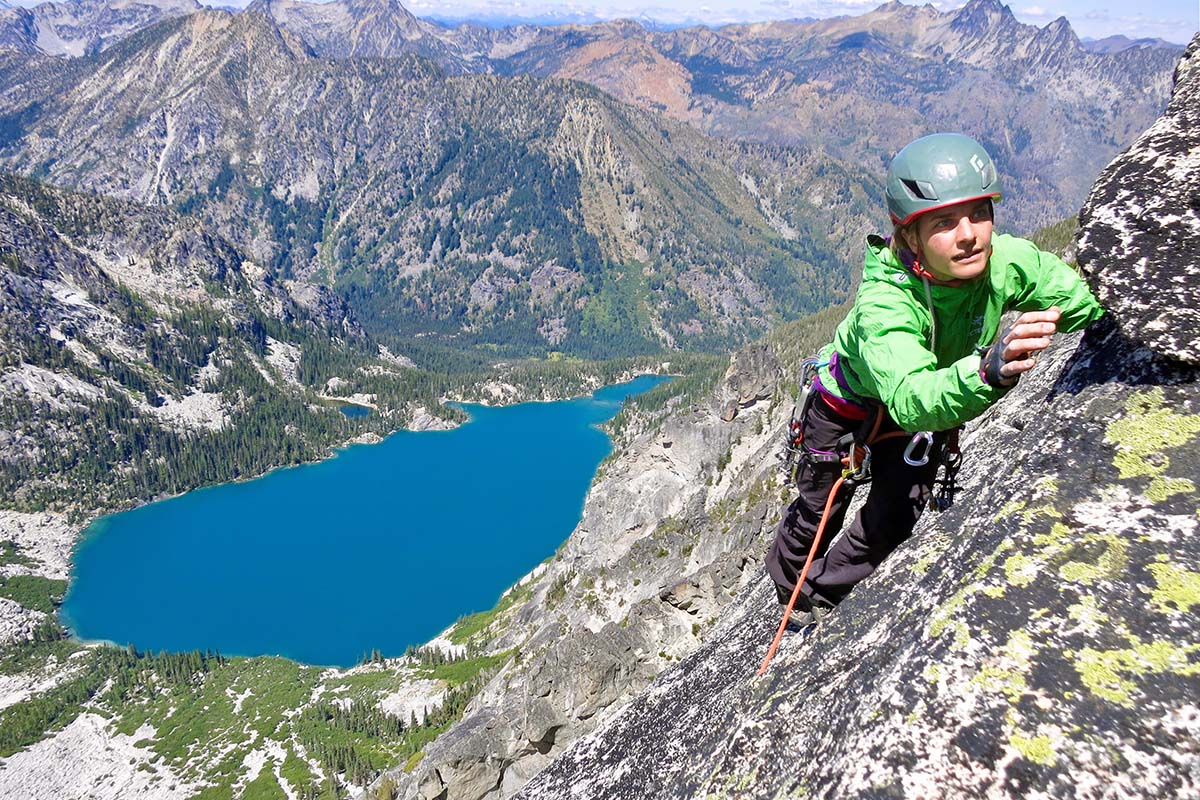
All that said, we’ve been incredibly impressed with the lifespan of most windbreakers that we’ve tested. They’re nowhere near as durable as hardshell jackets, but over the years, our collective windbreakers have endured excessive groveling in chimneys while climbing, being stuffed into packs beside crampons and sticky skins, and day in and day out use. In the end, we can recall a few durability issues, including one rip (which took place while alpine rock climbing) and one busted zipper (that Patagonia dutifully repaired). All in all, the impressive durability of windbreakers is just one more feather in the cap of these small but mighty jackets.
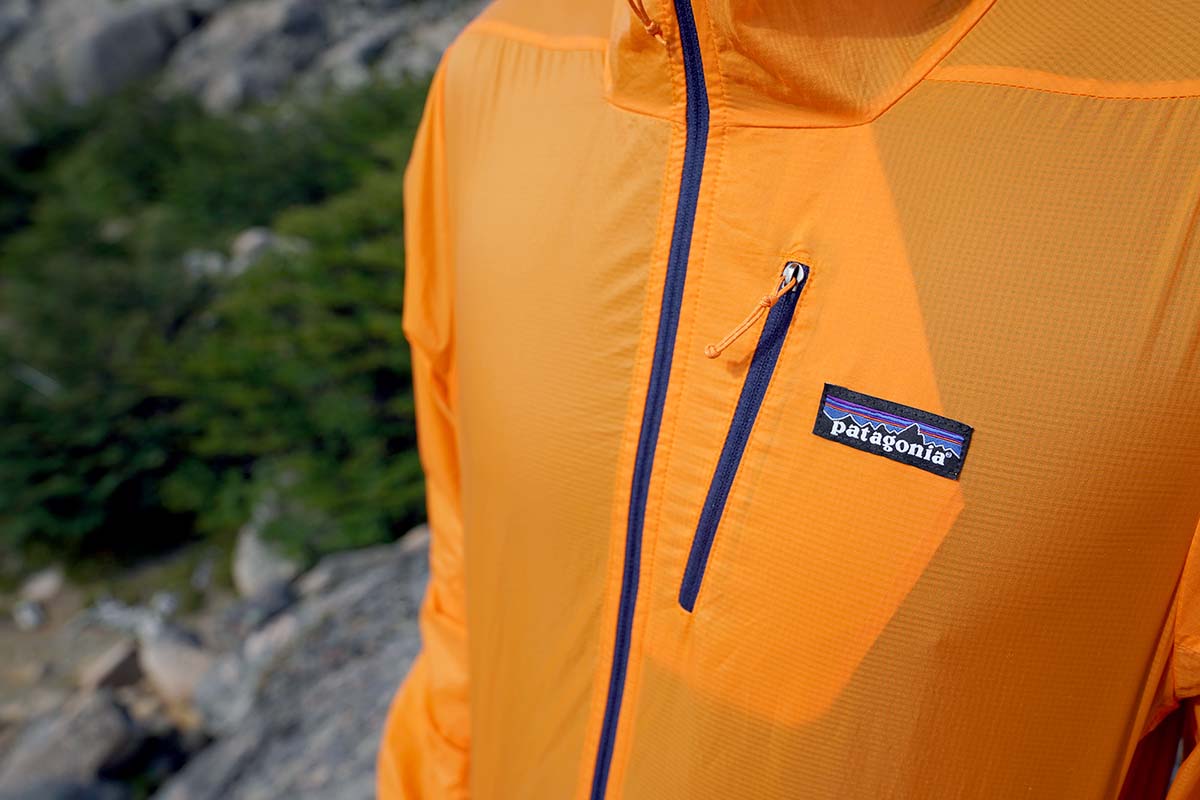
Windbreakers are fairly low-maintenance, but there are a few steps you can take toward increasing the life of your jacket. First, we never recommend storing a jacket stuffed in its pocket. Like a sleeping bag, your windbreaker needs to breathe and should be hung alongside your other jackets when not in use. Second, it’s best to follow the manufacturer's instructions for washing and drying, which usually entail machine washing with cold water and tumble drying (take note that your windbreaker will dry much more quickly than the rest of your laundry). It might seem counterintuitive, but regular laundering is actually vital to maintaining the water-repellant finish. And if your DWR begins to lose its effectiveness, it’s fairly simple to reapply with a product like Nikwax’s TX.Direct.

One of the primary ways we see manufacturers innovating is through the use of more sustainable materials. In terms of windbreaker jackets, this means recycled fabrics, more responsible production practices (including the elimination of some harmful "forever chemicals" from water repellent finishes), and an emphasis on the ethical treatment of workers. Many companies also utilize the Bluesign system for sourcing materials responsibly. Patagonia is a huge leader in this movement (their Houdini is built with 100%-recycled nylon with a PFC-free DWR), but windbreakers from brands like Cotopaxi and Black Diamond also feature impressive sustainability measures. And while we encourage you to shop responsibly, we’re also big advocates of lowering consumption by reusing old gear. Many brands offer repair programs and used marketplaces for their offerings, and gear consignment stores can be treasure troves for like-new items.
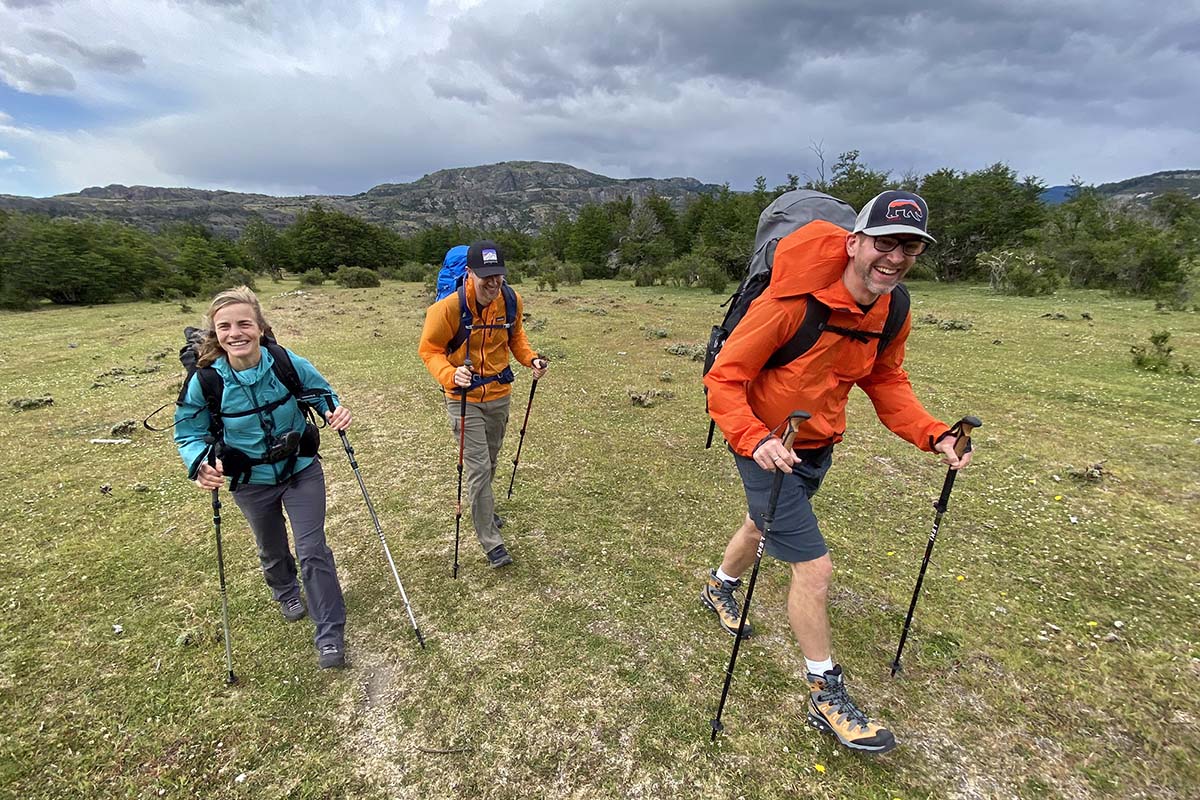
When it comes to choosing your outer shell, you have a few options, including a windbreaker, softshell, rain jacket, or hardshell. Especially given the increasing amount of crossover between categories, it can be difficult to determine what style is best for your needs. In general, a softshell jacket is an ideal layer for active pursuits when you want a bit of wind and water protection but don’t want to give up breathability and freedom of movement. On the other hand, a rain jacket (or burlier hardshell) will provide full protection from the elements, but often at the expense of breathability, comfort, and mobility. For active pursuits when the conditions aren’t nasty, we think that windbreakers offer a nice alternative to both full-on waterproof jackets and softshells, and here’s why.
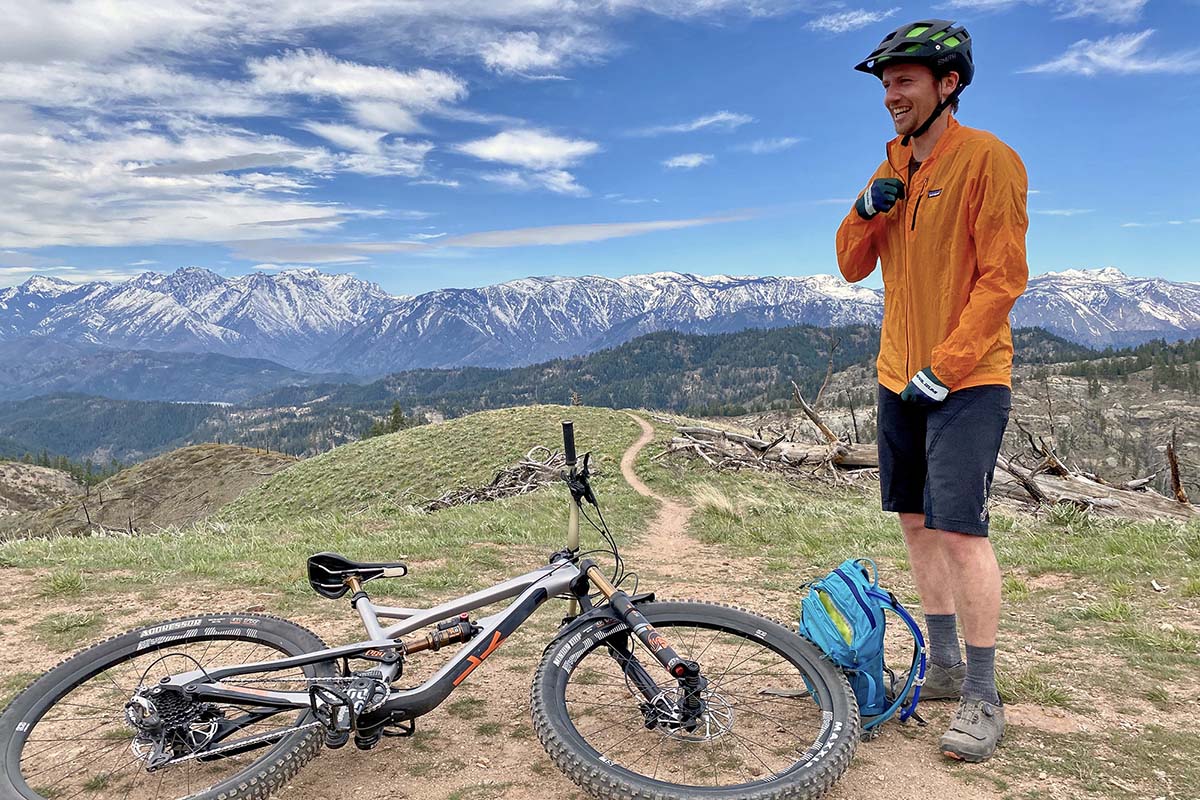
Unless you live in the rainforest of British Columbia or are particularly inclined towards sufferfests, we’re guessing that the majority of your outdoor activities take place during fair weather (at worst, a light drizzle, wet snow, or sustained wind). We’re also guessing that you’re moving during these activities, which means you’re generating body heat. You could bring a rain jacket along, but chances are it doesn’t breathe very well and will be overkill for most weather (our rain jacket spends most of its life at the bottom of our pack). On the other hand, a softshell will give you all the protection you need, along with great breathability and freedom of movement, but most are prohibitively heavy and bulky.
Enter the windbreaker jacket. Windbreakers are lightweight, packable, and easily stay stuffed away until you need them. They’re capable of cutting a serious wind (most of the time, this will be enough to keep you warm), and most are fairly impressive at keeping out a light rain (all but a few in our round-up feature a DWR finish). Many modern windbreakers are highly breathable too, and we’ve begun to see more and more with built-in stretch for better freedom of movement. If you’re keeping score, this means you get all the benefits of a softshell jacket in a more streamlined package. In the end, we’re not shy in our opinion that a high-performance windbreaker (the Outdoor Research Wind Shadow and Black Diamond Alpine Start, for example) is the most versatile style of jacket on the market and the best outer layer for the majority of active pursuits.
Back to Our Top Windbreaker Picks Back to Our Windbreaker Comparison Table